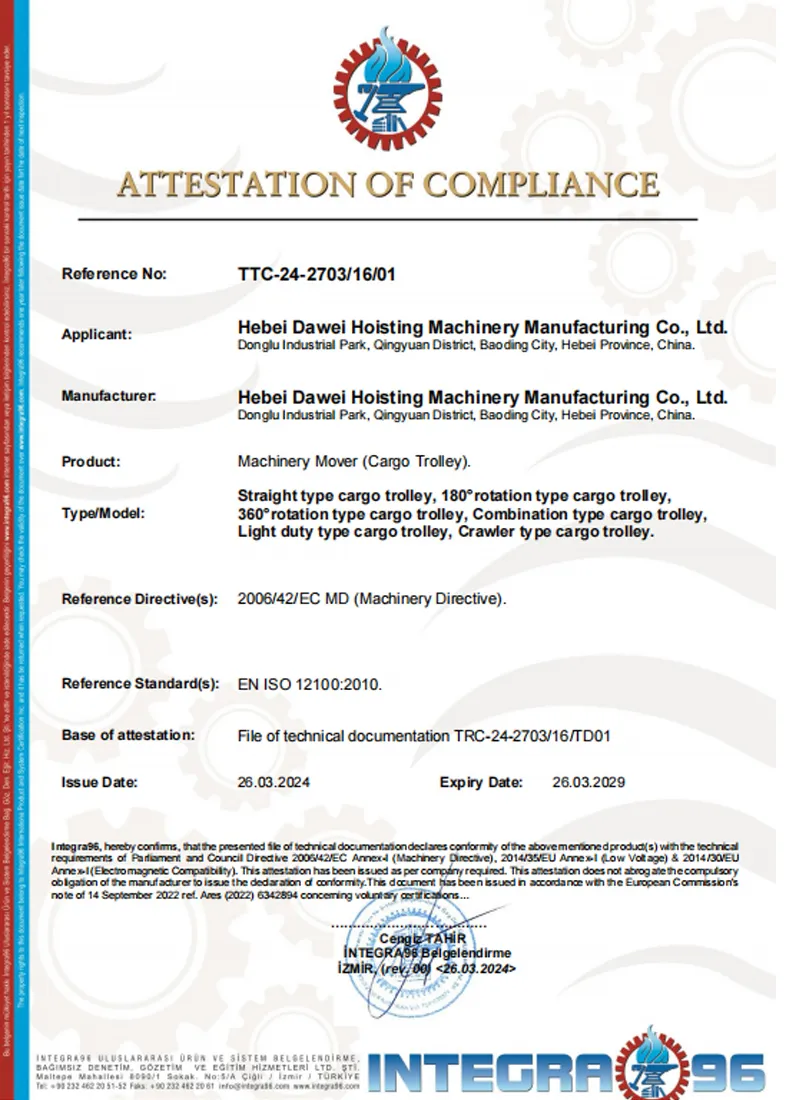the gantry crane
Understanding Gantry Cranes A Comprehensive Overview
Gantry cranes are an essential piece of equipment in various industrial and construction environments. With their distinctive design and versatility, these cranes are indispensable for lifting, moving, and placing heavy loads with precision. This article aims to provide a detailed understanding of gantry cranes, including their structure, applications, advantages, and maintenance.
What is a Gantry Crane?
A gantry crane is a type of bridge crane that consists of a framework that supports a hoist. It typically features two vertical legs that support a horizontal beam, or girder, that spans the distance between the legs. This structure allows the crane to move along a set of tracks on the ground, making it an ideal solution for loading and unloading tasks, particularly in outdoor environments where traditional overhead cranes might not be feasible.
Key Components of Gantry Cranes
1. Gantry Structure The most recognizable aspect of a gantry crane is its A-frame design. This provides stability and strength, enabling the crane to lift heavy loads securely.
2. Hoist Mechanism Similar to other types of cranes, gantry cranes are equipped with a hoist system that includes a motor, pulleys, and a hook. The hoist can lift loads vertically, and its speed and power can vary depending on the crane’s specifications.
3. Trolley The trolley moves along the top of the gantry structure, allowing for lateral movement of the hoisted load. This flexibility increases the crane's functionality and efficiency.
4. Mobility System Many gantry cranes are designed to be mobile, utilizing wheels that allow them to move along designated tracks or across a flat surface.
Applications of Gantry Cranes
Gantry cranes are used in a myriad of applications across different industries, including
- Construction They are particularly useful on construction sites for moving heavy materials such as pre-cast concrete, steel beams, and other heavy equipment.
- Shipping and Dockyards Gantry cranes are vital for loading and unloading cargo containers from ships, allowing for efficient transport and handling of goods.
- Manufacturing In factories, gantry cranes assist in the assembly process by moving components and finished products between different stages of production.
- Warehousing They facilitate the storage and retrieval of heavy items, making inventory management more efficient
.the gantry crane

Advantages of Gantry Cranes
The design and functionality of gantry cranes offer several advantages
1. Cost-Effective Gantry cranes are often more affordable than traditional overhead cranes, as they require less infrastructure and can be constructed using less expensive materials.
2. Versatility They can be customized to meet specific lifting needs, with adjustable heights and spans depending on the application.
3. Ease of Use Gantry cranes are generally user-friendly, simplifying the loading and unloading processes, which helps to reduce labor costs and improve productivity.
4. Mobility Many gantry cranes are portable, allowing them to be relocated easily for various tasks.
5. Durability Built to withstand tough working conditions, gantry cranes are designed to be robust and long-lasting, which minimizes downtime and maintenance costs.
Maintenance Considerations
Maintaining a gantry crane is crucial for safety and efficiency. Regular inspections are vital to ensure that all components are functioning correctly and that there are no signs of wear or damage. Key maintenance tasks include
- Lubrication Regular lubrication of moving parts to reduce friction and wear.
- Inspection of the Hoist and Trolley Ensuring that the hoist mechanism and trolley are in good working order.
- Checking Structural Integrity Inspecting the gantry frame and legs for any signs of bending or cracking.
- Electrical System Checks For electric gantry cranes, it is important to regularly check wiring and connections for safety.
In conclusion, gantry cranes play a critical role in the efficiency and safety of material handling in various industries. Their unique design, coupled with their flexibility and cost-effectiveness, makes them an invaluable asset for many operations. Proper maintenance and regular inspections ensure their longevity and reliable performance, allowing businesses to maximize productivity in their lifting operations. Understanding the various aspects of gantry cranes will aid in making informed decisions when selecting the right equipment for specific needs.
-
Versatile Lifting Solutions with Gantry and Overhead CranesNewsAug.29,2025
-
The Versatile Mobile Gantry Crane SolutionNewsAug.29,2025
-
Reliable Movement with Heavy Machinery Skates and RollersNewsAug.29,2025
-
Reliable Lifting Performance with 2000 lb Gantry Crane and 2 Ton Overhead SystemsNewsAug.29,2025
-
Maximize Lifting Efficiency with PML Magnetic LiftersNewsAug.29,2025
-
Efficient Relocation Starts with Reliable Machinery MoversNewsAug.29,2025
-
Efficient and Safe Lifting with Permanent Magnetic LiftersNewsAug.29,2025
